mounting a radiopopper on a puffer
05.15.08 | photo-resources
no, folks, we're not breeding anything illegal
here... just making the minor under-the-hood
modification to gary fong's $20 puffer
pop-up flash diffuser that is required
to safely mount a radiopopper p1 transmitter
behind a camera's pop-up flash.
with a little macgyver inspiration, some glue, velcro, and a spare battery cover we're able to do the unthinkable: use our wonderful in-camera pop-up flash as a commander to trigger an off-camera flash using absolute brilliant radiopopper p1 functionality.
paper clips and chewing gum not needed on this mission :)
the radiopopper p1 owner's manual states: "The P1 system was never designed to work with the so called “pop-up” flash on some Nikon cameras, but it does indeed function and activate. Mounting is somewhat “improvised” at the user’s discretion. A mount may be available in the future. Improvised mounting should attempt to place the external pickup sensor directly behind the flash tube inside the pop-up flash."
uh, "may be available," makes me impatient. so, i macgyvered an "improvised" mount to change the phrase "is available." btw, this works waaaay better than the piece of black gaffer's tape illustrated in my full radiopopper review. you all are smart, so with a few photos, you'll be off making your own radiopopper bracket in no time.
the ingredients are rather simple:
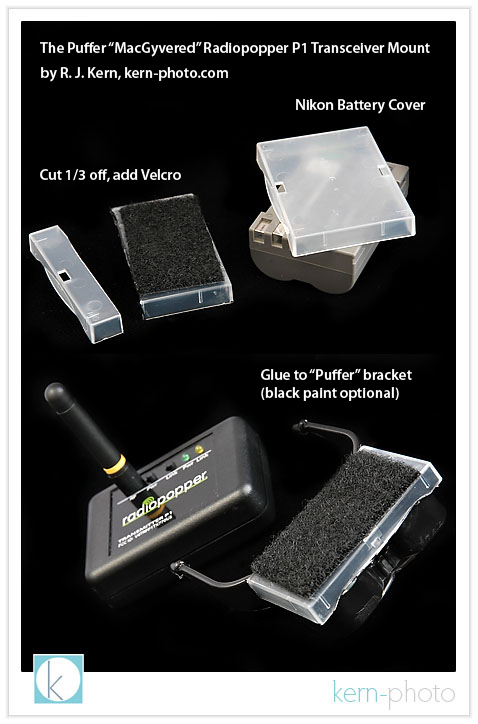
here's the skinny:
1. the plastic welder can be found for about $5 at your local hardware store. super glue is not recommended, as the hold is not as strong. you do not want to rip off your bracket while trying to remove your velcroed radiopopper p1 transmitter. schmear it on good. allow plenty of time to dry.
2. the rechargeable lithium-ion plastic battery cover is the secret. it is supplied with any new nikon d50, d70, d70s, d80, d100, d200, and d300 camera which all use the same e-nel3e (if you purchase a spare, it ships with that, too) . i never use mine since my batteries are either in the camera on a recharger. the reason battery cover is ideal: it ain't too big or small, is rectangular, and has a nice 1/4" lip to bolster the surface area you'll want when you are gluing. you have limited real estate on the base of the transmitter and do not want to cover up the screws sealing access to the single AA battery compartment (poor design). using an sharp blade, cut the battery cover 1/3 lengthwise. you'll want to use the remaining 2/3 portion for the mount. if you can think of something cool to do with the remaining end, be sure to contact us and comment in the blog below.
if you do not have a battery cover, those little, clear compact flash card cases work almost just as well. i say almost because they are a little larger and do not make as snug of a fit as the battery cover. you'll want a close fit to ensure a solid gluing surface.
3. industrial-strength velcro... you might as well purchase some industrial-strength velcro while you are at the hardware store. you can buy it by the foot for about $1 or so. don't get the cheap stuff, which picks up lint and over time the strength of the fastener will decrease. adhere the "fuzzy end" on your old battery cover and the "hook end" on your poppers. if you want mounting velcro on another flash, use the "fuzzy end" as well. if you don't , the "hook end" of the velcro will stick to the inside of your camera bag in a big way :)
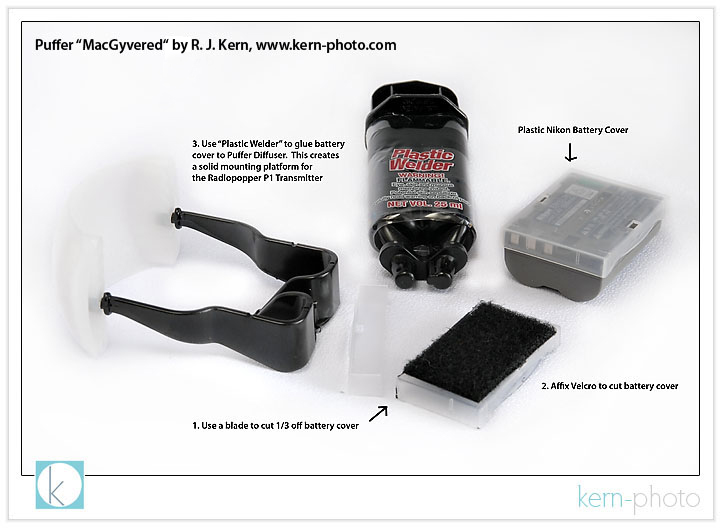
before & after:
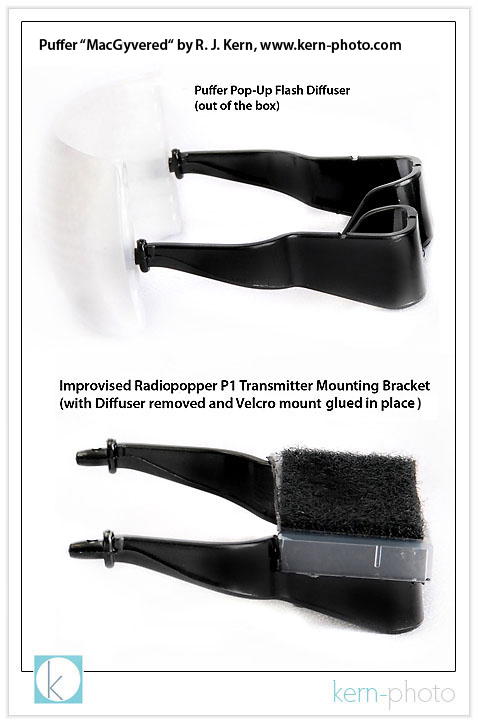
after the newly-cut battery cover was glued to the puffer bracket, i used some black acrylic paint with a small brush and painted the underneath to conceal the "clear" color and the ugly dried paint, making the whole shebang a bit more uniformly "black."
now, it is ready for mounting :)
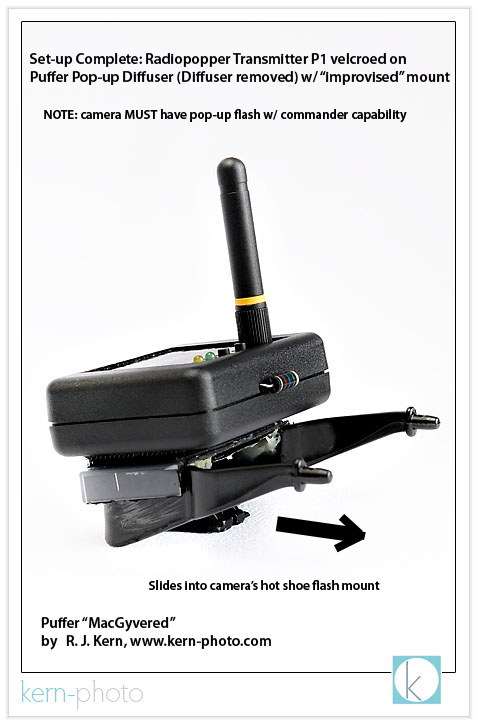
you can use the puffer as it was intended or remove it. however, if people are paying you to take their picture, i would gently recommend removing the white diffusion dome :)
my initial thoughts on the puffer:
1. you get what you pay for. too bad you spend $8 to ship $19.95 in plastic.
2. the plastic is brittle. i would not use in cold conditions.
3. the puffer doesn't stay secured very well on its own, so it might need some strong glue to adhere it. however, that would make it prone to break if you toss it in a bag. totally up to you.
4. the puffer works decent to diffuse the apuny low-powered pop-up flash and
ideal uses might include a fill-light for a close
subject. otherwise, i'd turn the flash off (read
your owner's manual for details. for nikon users,
ensure the "--" marks are shown in the commander
menu and not any of the alphabet soup settings,
i.e. ttl, aa, m, etc.)
5. i experienced some trouble with quality assurance & control at gary fong, inc's customer service department. after placing my order (initially, shipping was *free*), i got a phone call the following day informing me that their "system" goofed and didn't charge shipping and that i now needed to pay the shipping charges of $8. huh? a few hours later after speaking with a supervisor, they agreed to reduce the shipping charges to $4. cool. then two boxes show up on my doorstep a few days later with two full-priced invoices enclosed. i only ordered one unit. after another phone call, the customer service rep was very kind and professional. they allowed me to keep the second unit at no cost, far more pleasant than a trip to the post office and return postage.
the bracket, on the other hand, is worth the $20. my guess is the plastic mold used in manufacturing cost lots of pretty pennies. it would be difficult to macgyver that from scratch.
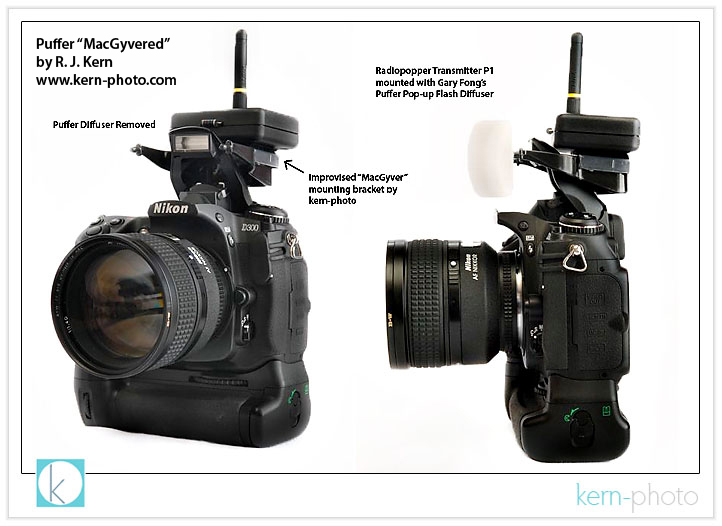
overall, this solution seems to work. i would say that this whole set-up is not a bombproof as a pocketwizard set-up, but at least it works. and remember, the "ideal" scenario would be to mount the transceiver to another speedlight and mount that on the camera. but for strobists on a dime, this solution should buy you time until you can afford the complete joe "nikon likes me" mcnally setup for several thousand dollars.
_______
and for giggles, here is a list of problems solved by the REAL macgyver. if you missed it, be sure to watch last week's SNL pee-your-pants hilarious "macgruber" skit here.
_______
if you've found this review help, feel free to add your comments below. think of it as our tip :)
with a little macgyver inspiration, some glue, velcro, and a spare battery cover we're able to do the unthinkable: use our wonderful in-camera pop-up flash as a commander to trigger an off-camera flash using absolute brilliant radiopopper p1 functionality.
paper clips and chewing gum not needed on this mission :)
the radiopopper p1 owner's manual states: "The P1 system was never designed to work with the so called “pop-up” flash on some Nikon cameras, but it does indeed function and activate. Mounting is somewhat “improvised” at the user’s discretion. A mount may be available in the future. Improvised mounting should attempt to place the external pickup sensor directly behind the flash tube inside the pop-up flash."
uh, "may be available," makes me impatient. so, i macgyvered an "improvised" mount to change the phrase "is available." btw, this works waaaay better than the piece of black gaffer's tape illustrated in my full radiopopper review. you all are smart, so with a few photos, you'll be off making your own radiopopper bracket in no time.
the ingredients are rather simple:
here's the skinny:
1. the plastic welder can be found for about $5 at your local hardware store. super glue is not recommended, as the hold is not as strong. you do not want to rip off your bracket while trying to remove your velcroed radiopopper p1 transmitter. schmear it on good. allow plenty of time to dry.
2. the rechargeable lithium-ion plastic battery cover is the secret. it is supplied with any new nikon d50, d70, d70s, d80, d100, d200, and d300 camera which all use the same e-nel3e (if you purchase a spare, it ships with that, too) . i never use mine since my batteries are either in the camera on a recharger. the reason battery cover is ideal: it ain't too big or small, is rectangular, and has a nice 1/4" lip to bolster the surface area you'll want when you are gluing. you have limited real estate on the base of the transmitter and do not want to cover up the screws sealing access to the single AA battery compartment (poor design). using an sharp blade, cut the battery cover 1/3 lengthwise. you'll want to use the remaining 2/3 portion for the mount. if you can think of something cool to do with the remaining end, be sure to contact us and comment in the blog below.
if you do not have a battery cover, those little, clear compact flash card cases work almost just as well. i say almost because they are a little larger and do not make as snug of a fit as the battery cover. you'll want a close fit to ensure a solid gluing surface.
3. industrial-strength velcro... you might as well purchase some industrial-strength velcro while you are at the hardware store. you can buy it by the foot for about $1 or so. don't get the cheap stuff, which picks up lint and over time the strength of the fastener will decrease. adhere the "fuzzy end" on your old battery cover and the "hook end" on your poppers. if you want mounting velcro on another flash, use the "fuzzy end" as well. if you don't , the "hook end" of the velcro will stick to the inside of your camera bag in a big way :)
before & after:
after the newly-cut battery cover was glued to the puffer bracket, i used some black acrylic paint with a small brush and painted the underneath to conceal the "clear" color and the ugly dried paint, making the whole shebang a bit more uniformly "black."
now, it is ready for mounting :)
you can use the puffer as it was intended or remove it. however, if people are paying you to take their picture, i would gently recommend removing the white diffusion dome :)
my initial thoughts on the puffer:
1. you get what you pay for. too bad you spend $8 to ship $19.95 in plastic.
2. the plastic is brittle. i would not use in cold conditions.
3. the puffer doesn't stay secured very well on its own, so it might need some strong glue to adhere it. however, that would make it prone to break if you toss it in a bag. totally up to you.
4. the puffer works decent to diffuse the a
5. i experienced some trouble with quality assurance & control at gary fong, inc's customer service department. after placing my order (initially, shipping was *free*), i got a phone call the following day informing me that their "system" goofed and didn't charge shipping and that i now needed to pay the shipping charges of $8. huh? a few hours later after speaking with a supervisor, they agreed to reduce the shipping charges to $4. cool. then two boxes show up on my doorstep a few days later with two full-priced invoices enclosed. i only ordered one unit. after another phone call, the customer service rep was very kind and professional. they allowed me to keep the second unit at no cost, far more pleasant than a trip to the post office and return postage.
the bracket, on the other hand, is worth the $20. my guess is the plastic mold used in manufacturing cost lots of pretty pennies. it would be difficult to macgyver that from scratch.
overall, this solution seems to work. i would say that this whole set-up is not a bombproof as a pocketwizard set-up, but at least it works. and remember, the "ideal" scenario would be to mount the transceiver to another speedlight and mount that on the camera. but for strobists on a dime, this solution should buy you time until you can afford the complete joe "nikon likes me" mcnally setup for several thousand dollars.
_______
and for giggles, here is a list of problems solved by the REAL macgyver. if you missed it, be sure to watch last week's SNL pee-your-pants hilarious "macgruber" skit here.
_______
if you've found this review help, feel free to add your comments below. think of it as our tip :)
